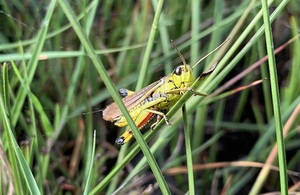Years of bog and fen decline had pushed the species out, but with dedicated work and modern techniques, Norfolk is now seeing one of its lost creatures thriving once again….reports Asian Lite News
Norfolk’s wetlands will once again echo with the distinctive ticking calls of the large marsh grasshopper, following its dramatic return after nearly nine decades away. The rare insect, once wiped out in the county by habitat destruction, has been successfully reintroduced thanks to an ambitious conservation drive that has captured the imagination of locals and experts alike.
The comeback is the result of Citizen Zoo’s Hop of Hope project, which allowed volunteers to home-rear and release thousands of grasshoppers into carefully restored wetland habitats. Years of bog and fen decline had pushed the species out, but with dedicated work and modern techniques, Norfolk is now seeing one of its lost creatures thriving once again.
The revival has been made possible through Natural England’s £13 million Species Recovery Programme Capital Grants scheme, a government initiative designed to halt the country’s biodiversity crisis. Hannah Thacker, area director for Natural England’s Norfolk and Suffolk team, hailed the breakthrough. “We’re delighted with the Hop of Hope project’s progress. Our partners have developed groundbreaking techniques using pre-incubated eggs to establish new populations in thriving habitats,” she said. Thacker added that the grasshoppers are not only surviving but breeding, creating self-sustaining colonies that prove nature’s resilience when given the right support.
For the first time since 1939, large marsh grasshoppers have now hatched in the wild in the Norfolk Broads. Conservationists say this is a major milestone in the government’s pledge to reverse species decline by 2030 and forms part of its wider Nature Recovery Network. Dr. Stuart Green of Citizen Zoo described the achievement as a turning point. “The grant has helped us reintroduce one of the UK’s rarest grasshoppers. Citizen Zoo relies on passionate volunteers, and funding like this is vital to success,” he said.

The return of the grasshopper is also being seen against the backdrop of England’s broader wildlife emergency. Species numbers have plummeted by more than half in recent decades, with one in eight assessed species now at risk of extinction. Against that grim picture, the sight and sound of the grasshopper in Norfolk is a sign that determined action and community involvement can bring species back from the edge.
Looking ahead, conservationists are keen to expand the project further. Hopes are high that the large marsh grasshopper could be reintroduced at more sites in Norfolk, provided the right funding and habitats can be secured. For now, its reappearance after 86 years is being celebrated as a victory for nature and a reminder that even the smallest creatures can make a huge noise when given the chance.









